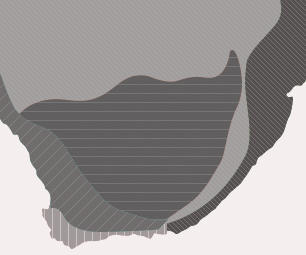Athrixia phylicoides
Athrixia phylicoides DC.
Family: Asteraceae
Common names: Bushman's tea (Eng.); Boesmanstee (Afr.); Icholocholo, itshelo, umthsanelo (isiZulu)
Introduction

This is a stunning plant that has a great horticultural potential in cultivation. Its beautiful flowers and the soft texture of the leaves make it an asset in your garden.
Description
Description
Athrixia phylicoides is a shrub of 1 m in height, with leafy stems throughout. The leaves are fine, linear, 30 x 10 mm, dark green and shiny above and grey-white and smooth below. The ray florets of the flowerheads are mauve, the disc florets yellow. Flowerheads are sessile, terminal and axillary towards the ends of the branches. This shrub will flower throughout the year depending on the area but the best flowering time is from March to May.

Distribution and habitat
Distribution description
It is widely distributed in the eastern part of South Africa from the Soutpansberg to Queenstown, King William's Town and East London; throughout KwaZulu-Natal from the coast to the Drakensberg. This shrub is found in grassland, forests, bushveld, rocky and sloping habitats.

Derivation of name and historical aspects
History
The genus name Athrixia is derived from the Greek word thrix meaning hair, which refers to the leaves. The specific epithet phylicoides means it resembles Phylica.
Uses
Use
Aside from its horticultural potential, this plant also has traditional economic uses. The Bushman used to make tea from the leaves of Athrixia phylicoides, hence its common name. It is used to make hard brooms. It is also chewed, for sore throats and coughs by the Sotho and Xhosa. The Venda are reported to use extracts from soaked roots and leaves as anthelmintics.
Growing Athrixia phylicoides
Grow
This beautiful plant may be used as a filler plant in the open spaces in flower beds, and is best used when planted in a group, though it works well as a specimen plant in the garden. It grows well in full sun and is quite hardy.
Athrixia phylicoides is best propagated from cuttings; it can be cut back and it will re-sprout. At Kirstenbosch, this plant grows in the Useful Plant Garden and it is always in flower.
References
- Gibson, J.M. 1975. Wild flowers of Natal (coastal region) . Natal Publishing Trust Fund, Natal Flora Publications Trust, Durban
- Hilliard, O.M. 1971. Compositae of Natal . University of Natal Press, Pietermaritzberg.
- Hutchings, A. 1996. An inventory of Zulu medicinal plants . University of Natal Press, University of Zululand and the National Botanical Institute.
- Pooley, E. 1998. A field guide to the wild flowers of KwaZulu-Natal and the eastern region . Natal Flora Publications Trust, Durban .
Credits
Giles Mbambezeli
Kirstenbosch NBG
May 2005
Plant Attributes:
Plant Type: Shrub
SA Distribution: Eastern Cape, Free State, Gauteng, KwaZulu-Natal, Limpopo, Mpumalanga
Soil type: Sandy, Loam
Flowering season: Late Summer
PH: Neutral
Flower colour: White, Mauve/Lilac
Aspect: Full Sun
Gardening skill: Easy
Special Features:
Horticultural zones









Rate this article
Article well written and informative
Rate this plant
Is this an interesting plant?
Login to add your Comment
Back to topNot registered yet? Click here to register.